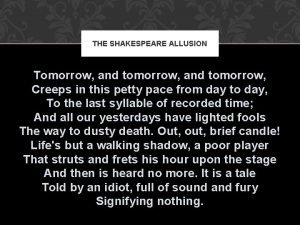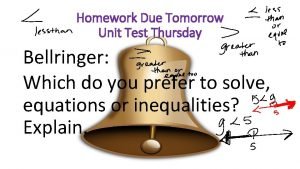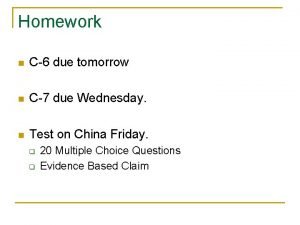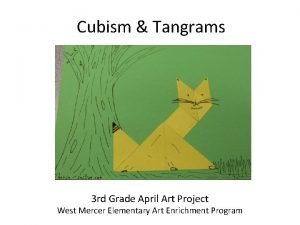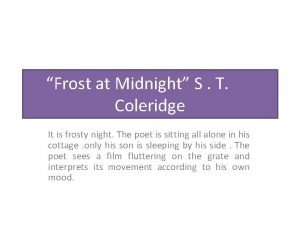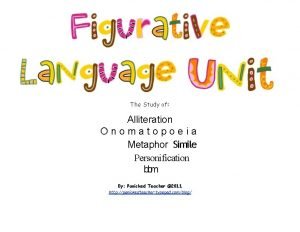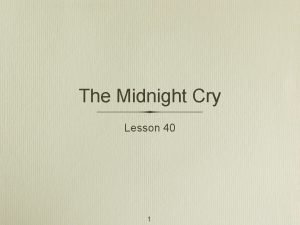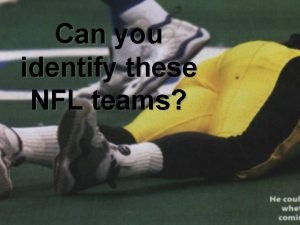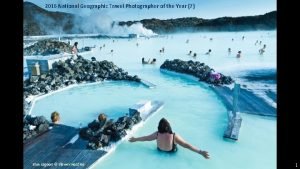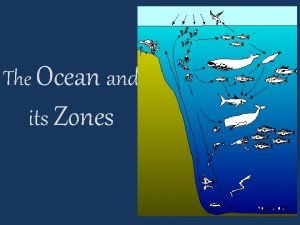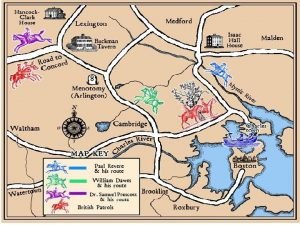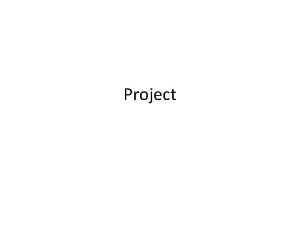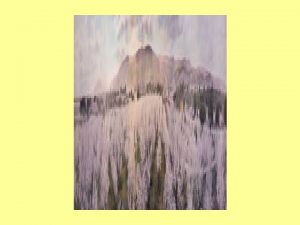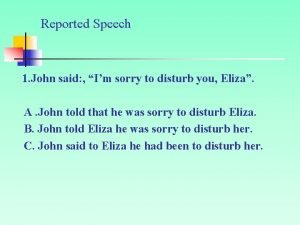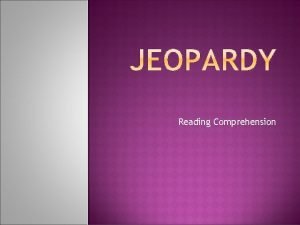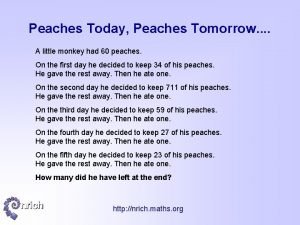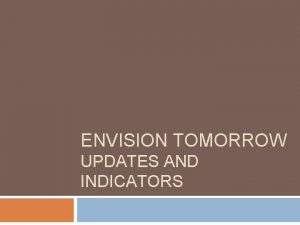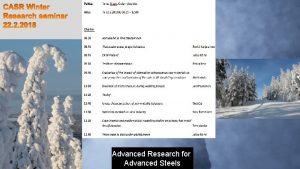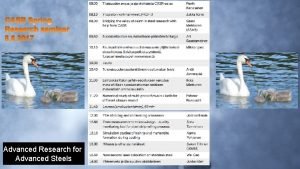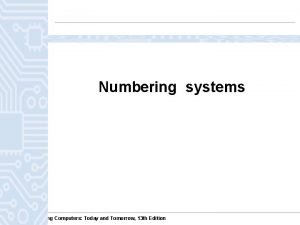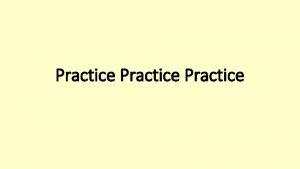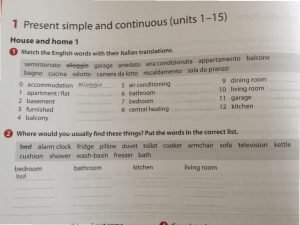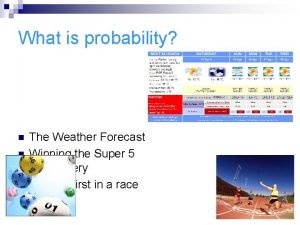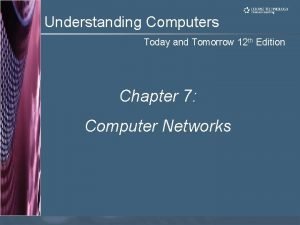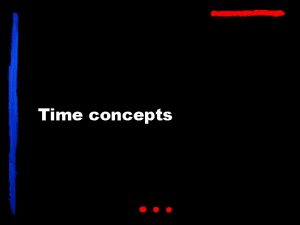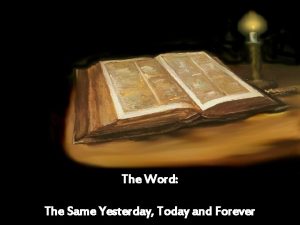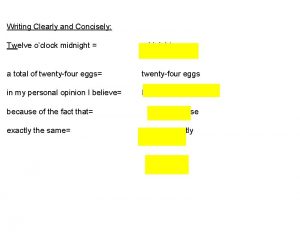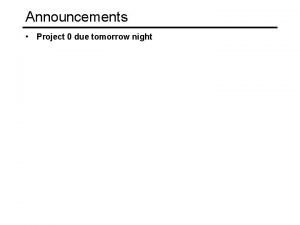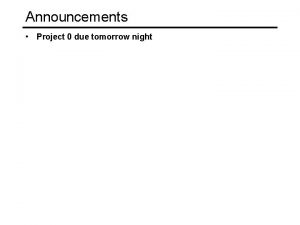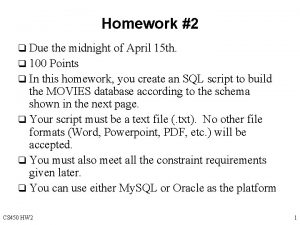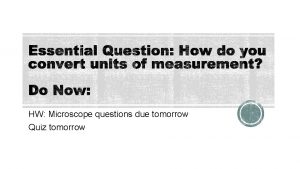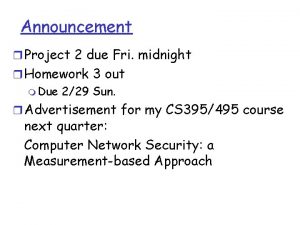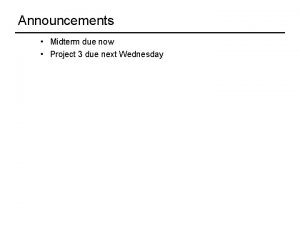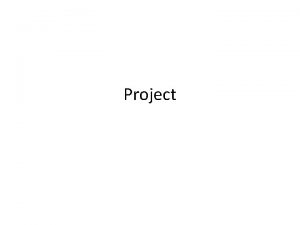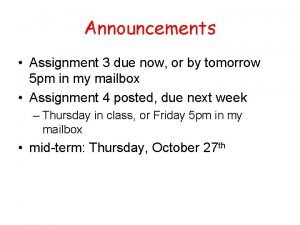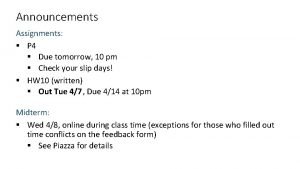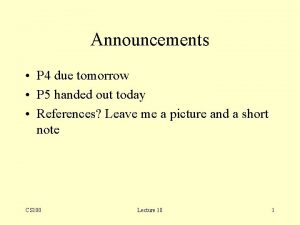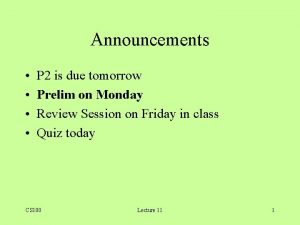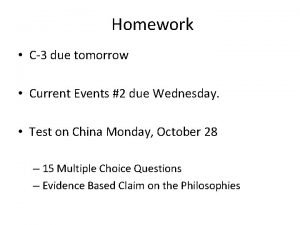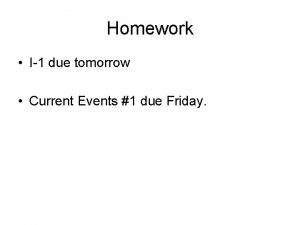Announcements Project 1 due April 16 tomorrow midnight







































































- Slides: 71

Announcements Project 1 due April 16 (tomorrow midnight) Project 2 will be assigned on Wed.

Mosaics Street. View Photosynth App Today’s Readings • Chapters 5. 1, 8. 1 in Szeliski • Szeliski and Shum paper (sections 1 and 2, skim the rest)

3

Image Mosaics + + … + = Goal • Stitch together several images into a seamless composite

How to do it? Basic Procedure • Take a sequence of images from the same position – Rotate the camera about its optical center • • Compute transformation between second image and first Shift the second image to overlap with the first Blend the two together to create a mosaic If there are more images, repeat

Aligning images How to account for warping? • Translations are not enough to align the images

Alignment Demo

Motion models What happens when we take two images with a camera and try to align them? • Translation • Rotation • Scale • Perspective 8

Image reprojection mosaic PP The mosaic has a natural interpretation in 3 D • The images are reprojected onto a common plane • The mosaic is formed on this plane

Image reprojection Basic question • How to relate two images from the same camera center? – how to map a pixel from PP 1 to PP 2 Answer • • Cast a ray through each pixel in PP 1 Draw the pixel where that ray intersects PP 2 PP 1 Don’t need to know what’s in the scene!

Image reprojection Observation • Rather than thinking of this as a 3 D reprojection, think of it as a 2 D image warp from one image to another

Image Warping image filtering: change range of image g(x) = h(f(x)) f g h x x image warping: change domain of image g(x) = f(h(x)) f g h x x

Image Warping image filtering: change range of image g(x) = h(f(x)) f g h image warping: change domain of image g(x) = f(h(x)) f h g 13

Parametric (global) warping Examples of parametric warps: translation affine rotation perspective aspect cylindrical 14

2 D coordinate transformations translation: x’ = x + t x = (x, y) rotation: x’ = R x + t similarity: x’ = s R x + t affine: x’ = A x + t perspective: x’ H x x = (x, y, 1) (x is a homogeneous coordinate) These all form a nested group (closed w/ inv. ) Richard Szeliski Image Stitching 15

Motion models Translation Affine Perspective 3 D rotation 2 unknowns 6 unknowns 8 unknowns 3 unknowns Richard Szeliski Image Stitching 16

Homographies Perspective projection of a plane • Lots of names for this: – homography, texture-map, colineation, planar projective map • Modeled as a 2 D warp using homogeneous coordinates p’ H p To apply a homography H • Compute p’ = Hp (regular matrix multiply) • Convert p’ from homogeneous to image coordinates – divide by w (third) coordinate

Image warping with homographies image plane in front image plane below black area where no pixel maps to

Homographies

Idea: projecting images onto a common plane each image is warped with a homography We’ll see what this homograph means later. First -- Can’t create a 360 panorama this way… mosaic PP

Panoramas What if you want a 360° field of view? mosaic Projection Sphere

Panoramas mosaic Projection Sphere

Spherical projection systems CAVE (UI Chicago) Omnimax

Spherical projection • Map 3 D point (X, Y, Z) onto sphere Y Z X unit sphere • Convert to spherical coordinates • Convert to spherical image coordinates – s defines size of the final image » often convenient to set s = camera focal length unwrapped sphere Spherical image

Spherical reprojection How to map sphere onto a flat image? • Y Z X side view top-down view to

Spherical reprojection How to map sphere onto a flat image? • to – Use image projection matrix! Y Z X side view top-down view – or use the version of projection that properly accounts for radial distortion, as discussed in projection slides. This is what you’ll do for project 2.

Radial distortion Correct for “bending” in wide field of view lenses Project to “normalized” image coordinates Apply radial distortion Apply focal length translate image center To model lens distortion • Use above projection operation instead of standard projection matrix multiplication

Spherical reprojection input f = 200 (pixels) f = 400 Map image to spherical coordinates • need to know the focal length f = 800

Aligning spherical images Suppose we rotate the camera by θ about the vertical axis • How does this change the spherical image?

Spherical warping Given focal length f and image center (xc, yc) φ (x, y, z) Y (sinθcosφ, sinφ, cosθcosφ) Z X cos φ sin φ cos θ cos φ

3 D rotation Rotate image before placing on unrolled sphere φ (x, y, z) cos φ (sinθcosφ, sinφ, cosθcosφ) Y Z X p=Rp sin φ cos θ cos φ _ _

Aligning spherical images Suppose we rotate the camera by θ about the vertical axis • How does this change the spherical image? • Translation by θ • This means that we can align spherical images by translation

Spherical image stitching What if you don’t know the camera rotation? • Solve for the camera rotations – Note that a pan (rotation) of the camera is a translation of the sphere! – Use feature matching to solve for translations of spherical-warped images

Computing transformations • Given a set of matches between images A and B – How can we compute the transform T from A to B? – Find transform T that best “agrees” with the matches

Computing transformations ?

Simple case: translations How do we solve for ?

Simple case: translations Displacement of match i = Mean displacement =

Simple case: translations • System of linear equations – What are the knowns? Unknowns? – How many unknowns? How many equations (per match)?

Simple case: translations • Problem: more equations than unknowns – “Overdetermined” system of equations – We will find the least squares solution

Least squares formulation • For each point • we define the residuals as

Least squares formulation • Goal: minimize sum of squared residuals • “Least squares” solution • For translations, is equal to mean displacement

Least squares formulation • Can also write as a matrix equation 2 n x 2 2 x 1 2 n x 1

Least squares • Find t that minimizes • To solve, form the normal equations

But not all matches are good What do we do about the “bad” matches?

RAndom SAmple Consensus Select one match, count inliers (in this case, only one)

RAndom SAmple Consensus Select one match, count inliers (4 inliers)

Least squares fit Find “average” translation vector for largest set of inliers

RANSAC • Idea: – All the inliers will agree with each other on the translation vector; the (hopefully small) number of outliers will (hopefully) disagree with each other • RANSAC only has guarantees if there are < 50% outliers

RANSAC Same basic approach works for any transformation • Translation, rotation, homographies, etc. • Very useful tool General version • Randomly choose a set of K correspondences – Typically K is the minimum size that lets you fit a model • Fit a model (e. g. , homography) to those correspondences • Count the number of inliers that “approximately” fit the model – Need a threshold on the error • Repeat as many times as you can • Choose the model that has the largest set of inliers • Refine the model by doing a least squares fit using ALL of the inliers

How big is s? • For alignment, depends on the motion model – Here, each sample is a correspondence (pair of matching points)

Assembling the panorama Stitch pairs together, blend, then crop

Problem: Drift Error accumulation • small errors accumulate over time

Problem: Drift (x 1, y 1) (xn, yn) copy of first image Solution • add another copy of first image at the end • this gives a constraint: yn = y 1 • there a bunch of ways to solve this problem – add displacement of (y 1 – yn)/(n -1) to each image after the first – compute a global warp: y’ = y + ax – run a big optimization problem, incorporating this constraint » best solution, but more complicated » known as “bundle adjustment”

Full-view Panorama + +

Different projections are possible

Project 2 Take pictures on a tripod (or handheld) Warp to spherical coordinates Extract features Align neighboring pairs using RANSAC Write out list of neighboring translations Correct for drift Read in warped images and blend them Crop the result and import into a viewer Roughly based on Autostitch • • By Matthew Brown and David Lowe http: //www. cs. ubc. ca/~mbrown/autostitch. html

Image Blending

Feathering + 1 0 =

Effect of window (ramp-width) size 1 left 1 right 0 0

Effect of window size 1 1 0 0

Good window size 1 0 “Optimal” window: smooth but not ghosted • Doesn’t always work. . .

Pyramid blending Create a Laplacian pyramid, blend each level • Burt, P. J. and Adelson, E. H. , A multiresolution spline with applications to image mosaics, ACM Transactions on Graphics, 42(4), October 1983, 217 -236.

Poisson Image Editing For more info: Perez et al, SIGGRAPH 2003 • http: //research. microsoft. com/vision/cambridge/papers/perez_siggraph 03. pdf

Alpha Blending I 3 p I 1 Optional: see Blinn (CGA, 1994) for details: I 2 http: //ieeexplore. ieee. org/iel 1/38/7531/00310740. pdf? is. Number =7531&prod=JNL&arnumber=310740&ar. St=83&ared=87&ar. Au hor=Blinn%2 C+J. F. Encoding blend weights: I(x, y) = (αR, αG, αB, α) color at p = Implement this in two steps: 1. accumulate: add up the (α premultiplied) RGBα values at each pixel 2. normalize: divide each pixel’s accumulated RGB by its α value Q: what if α = 0?

Image warping h(x, y) y’ y x f(x, y) x’ g(x’, y’) Given a coordinate transform (x’, y’) = h(x, y) and a source image f(x, y), how do we compute a transformed image g(x’, y’) = f(h(x, y))?

Forward warping h(x, y) y’ y x f(x, y) x’ g(x’, y’) Send each pixel f(x, y) to its corresponding location (x’, y’) = h(x, y) in the second image Q: what if pixel lands “between” two pixels?

Forward warping h(x, y) y’ y x f(x, y) x’ g(x’, y’) Send each pixel f(x, y) to its corresponding location (x’, y’) = h(x, y) in the second image Q: what if pixel lands “between” two pixels? A: distribute color among neighboring pixels (x’, y’) – Known as “splatting”

Inverse warping h-1(x, y) y’ y x f(x, y) x’ g(x’, y’) Get each pixel g(x’, y’) from its corresponding location (x, y) = h-1(x’, y’) in the first image Q: what if pixel comes from “between” two pixels?

Inverse warping h-1(x, y) y’ y x f(x, y) x’ g(x’, y’) Get each pixel g(x’, y’) from its corresponding location (x, y) = h-1(x’, y’) in the first image Q: what if pixel comes from “between” two pixels? A: resample color value – We discussed resampling techniques before • nearest neighbor, bilinear, Gaussian, bicubic

Forward vs. inverse warping Q: which is better? A: usually inverse—eliminates holes • however, it requires an invertible warp function—not always possible. . .

Other types of mosaics Can mosaic onto any surface if you know the geometry • See NASA’s Visible Earth project for some stunning earth mosaics – http: //earthobservatory. nasa. gov/Newsroom/Blue. Marble/ – Click for images…
 Macbeth tomorrow speech
Macbeth tomorrow speech Tomorrow and tomorrow and tomorrow kurt vonnegut analysis
Tomorrow and tomorrow and tomorrow kurt vonnegut analysis Due tomorrow do tomorrow
Due tomorrow do tomorrow Due tomorrow do tomorrow
Due tomorrow do tomorrow Homework due tomorrow
Homework due tomorrow Pvu official announcement
Pvu official announcement R/announcements!
R/announcements! Church announcements
Church announcements Fahrenheit 451 burning bright summary
Fahrenheit 451 burning bright summary Kluver bucy syndrome
Kluver bucy syndrome General announcements
General announcements Quattro lati
Quattro lati Procedural vs substantive due process
Procedural vs substantive due process Slidetodoc.com
Slidetodoc.com Principio di conservazione della quantità di moto
Principio di conservazione della quantità di moto April art project
April art project What is the 2 midnight rule
What is the 2 midnight rule Elisha goodman job prayer points
Elisha goodman job prayer points One way ticket to midnight
One way ticket to midnight Midnight train to georgia lyrics meaning
Midnight train to georgia lyrics meaning Many mumbling mice warm up
Many mumbling mice warm up Frost at midnight line by line explanation
Frost at midnight line by line explanation Personification definition and examples
Personification definition and examples Who wrote midnight cry
Who wrote midnight cry Midnight zone
Midnight zone Midnight zone
Midnight zone 10 in military time
10 in military time It came upon a midnight clear images
It came upon a midnight clear images Wise sunbathers football team
Wise sunbathers football team The midnight ride of paul revere (painting)
The midnight ride of paul revere (painting) Midnight.commass
Midnight.commass Midnight stars make bright the skies
Midnight stars make bright the skies Midnight oil creative
Midnight oil creative Midnight time
Midnight time Saurabh paranjape location
Saurabh paranjape location Horizontal zones of sea
Horizontal zones of sea Parable of the midnight visitor
Parable of the midnight visitor Midnight ride map
Midnight ride map Thank you o my father
Thank you o my father Final project due
Final project due When is the research project due
When is the research project due Where tradition meets tomorrow
Where tradition meets tomorrow Weathr for tomorrow
Weathr for tomorrow Tomorrow needs us lyrics
Tomorrow needs us lyrics Direct and indirect speech table
Direct and indirect speech table John said that he was sorry
John said that he was sorry A book of over 1 000 knock-knock jokes author's purpose
A book of over 1 000 knock-knock jokes author's purpose Peach today's the day
Peach today's the day Yesterday
Yesterday Unsullied definition in to kill a mockingbird
Unsullied definition in to kill a mockingbird Tomorrow i am going
Tomorrow i am going Envision tomorrow
Envision tomorrow Tomorrow casr
Tomorrow casr Tomorrow casr
Tomorrow casr Themes in romeo and juliet act 3
Themes in romeo and juliet act 3 Computer today and tomorrow presentation
Computer today and tomorrow presentation Example of repeated subtraction
Example of repeated subtraction Schoolified
Schoolified Past of am
Past of am Lightweight innovations for tomorrow
Lightweight innovations for tomorrow Learn today lead tomorrow
Learn today lead tomorrow Lodi unified school district board meeting live
Lodi unified school district board meeting live Quiz tomorrow
Quiz tomorrow I know who holds tomorrow hymn lyrics
I know who holds tomorrow hymn lyrics Elvis presley tomorrow never comes
Elvis presley tomorrow never comes If your homework last night
If your homework last night What is the weatherlike today
What is the weatherlike today Nnn weather
Nnn weather Unit 13 for a better tomorrow
Unit 13 for a better tomorrow Understanding computers today and tomorrow
Understanding computers today and tomorrow 2moviego
2moviego Same today tomorrow and forever
Same today tomorrow and forever
